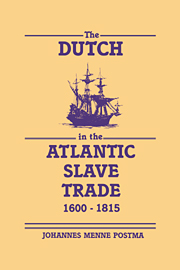Book contents
- Frontmatter
- Contents
- List of tables, figures, and maps
- Preface
- 1 Foundations of the slave traffic, 1600–61
- 2 Curaçao and the asiento trade, 1650–1730
- 3 The Dutch on the West African coast
- 4 Trade and politics on the African coast
- 5 Volume of African exports and origins of slaves
- 6 Organization and mechanics of the trade
- 7 The triangular trade
- 8 The Dutch plantation colonies under WIC monopoly, 1618–1738
- 9 The era of the free trade, 1730–80
- 10 The slaves: their treatment and mortality
- 11 Finances, marketing, and profitability
- 12 The end of the Dutch slave trade, 1781–1815
- Appendixes
- Bibliography
- Index
- Frontmatter
- Contents
- List of tables, figures, and maps
- Preface
- 1 Foundations of the slave traffic, 1600–61
- 2 Curaçao and the asiento trade, 1650–1730
- 3 The Dutch on the West African coast
- 4 Trade and politics on the African coast
- 5 Volume of African exports and origins of slaves
- 6 Organization and mechanics of the trade
- 7 The triangular trade
- 8 The Dutch plantation colonies under WIC monopoly, 1618–1738
- 9 The era of the free trade, 1730–80
- 10 The slaves: their treatment and mortality
- 11 Finances, marketing, and profitability
- 12 The end of the Dutch slave trade, 1781–1815
- Appendixes
- Bibliography
- Index
Summary
Notes and sources.
The following two appendixes list essential data on documented Dutch slave ships for the 1675 to 1802 period. Ships are listed in alphabetical order, with multiple missions in chronological order. Appendix 1 includes a total of 370 slaving missions, sailing in the 1675 to 1738 period under the auspices of the WIC, except for six interloper ships that are identified with a + sign. The ^ sign at the end of some ship names indicates that they were special assignments authorized by the WIC authorities in Africa. Appendix 2 includes a total of 840 slaving missions for the free-trade period from 1730 to 1802. Additional and more specialized data for some of these slaving voyages are given in subsequent appendixes.
Key to abbreviations and explanatory notes
In some instances, the names of the ships listed in the first column, “Ships,” have been abbreviated to save space. For example, Amsterdam and Middelburg have occasionally been listed as A'dam and M'burg. The documents frequently misspelled or gave different variations in spelling of names. For the sake of consistency, the most frequently used or simplest rendition of the name has been employed in the lists.
The next column “Hol.” indicates the missions' port or region of origin in the Dutch Republic. The following abbreviations have been employed: AM = Amsterdam; Z = Zeeland province; M = Maze (Rotterdam region); NK = Noorder Kwartier (Holland north of Amsterdam); SL = Stad en Lande (The Groningen/Friesland region).
- Type
- Chapter
- Information
- The Dutch in the Atlantic Slave Trade, 1600–1815 , pp. 304 - 411Publisher: Cambridge University PressPrint publication year: 1990

